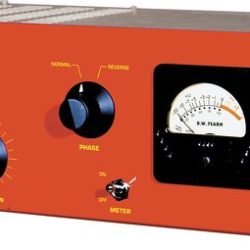Handmade, all-tube preamp with point-to-point wiring and mil-spec components.
Microphone preamplifiers from D.W. Fearn’s VT-series will change the way you think of audio quality. The transparency is astounding. Vocals sound smoother, warmer, more intimate, with a compelling presence. Any microphone and any sound will benefit from the improved clarity, definition, and lack of solid-state artifacts.
The VT-1 from tube guru D.W. Fearn recreates the sound of classic tube preamps of the 1960s. Modern components and computer-optimized circuitry, unavailable during the vacuum tube era, elevate this design to a new level of performance.
The VT-1 preamplifier was designed for optimal sonic quality, reliability, and durability. Like the best tube equipment of the 1950s and ’60s, the VT-1 is built on a heavy-gauge aluminum chassis, utilizing point-to-point wiring. Each vacuum tube is selected for minimum noise and microphonics, and maximum sound clarity. The front panel switches control sealed, gold-contact precision relays for all audio switching, eliminating the possibility of dirty contacts degrading the sound and minimizing the internal audio path. Four class-A triode amplifier sections (in two tubes) in each channel comprise the entire active circuit. This surprisingly simple circuit, along with top-quality components and careful design optimization, results in the sonic superiority that the VT-1 has become known for. All over the globe, VT-1 mic preamps are in daily use in the world’s best studios, as well as in home project studios, helping many top recording artists achieve the best possible sound.
Important Note: Due to heat given off by tubes, D.W. Fearn recommends that you provide at least one rack unit (RU) of space above and below their audio rack products. For proper cooling and a refined look for your rack, we highly recommend using D.W. Fearn Vented Rack Panels (#180296).
Dual-channel version D.W. Fearn VT-2 also available (see #180272).
History of the VT-1 and VT-2 Vacuum Tube Microphone Preamplifiers
One day in 1991, I was going through some old masters in a closet at home and came across a reel from 1968. It was one of the first studio recordings I ever made. I pulled the tape box off the shelf and thought about those days. Although I suspected that the recording might be a bit crude, I remembered that the music was pretty good, so I made a cassette to listen to in the car.
I kept forgetting to put the cassette in my pocket for a few days, but finally I remembered to take it. That old recording brought back memories of my first studio — and how primitive a setup it was. But listening to that tape was a revelation; some of the sounds were really nice. The vocals were full and warm but still punched through. Acoustic guitars had a depth I don’t often hear in current recordings. And the sax solo — wow! It ripped through with a grossly distorted but beautifully powerful sound.
That recording was done on a 4-track Scully 280 and mixed to a 2-track Scully. My prize microphone was a Neumann U-87 and that’s what was probably on the featured instrument or voice on each track; nothing too unusual about that.
I couldn’t afford the Electrodyne board of my dreams back then. In fact, I built the “mixer” myself. It consisted of half a dozen RCA tube microphone preamplifiers that I salvaged from the junk pile of the radio station where I worked, an equal number of old Daven rotary faders, and key switches that “panned” the output to left, center, or right.
It was the tube preamps that made that recording sound so good. There was no EQ, no reverb, but maybe just a touch of compression on some sounds, from an old broadcast type (tube) limiter.
These preamps were 1940s vintage. They used octal metal tubes with a shielded grid cap, a cylindrical output transformer the size of a coffee can, and a huge power supply on a separate chassis. They were a lot of trouble — the tubes were microphonic and the output was often noisy. In addition to the hums and hisses, occasionally a take would be ruined by crackles and bangs from the tubes. I couldn’t wait to get rid of the things.
And so I did, not long after. I got a beautiful console with IC op amps, linear faders, real panpots, echo sends and returns, and EQ on every input. No more noisy tubes for me.
But now, 25 years later, I got to thinking about the sound of those tubes. Hit them with a bit of excessive level and the sound became real fat. Hit them with just the right level and they sounded warm and intimate. Could that sound be duplicated today? I dug out my old RCA Receiving Tube Manual and several other old reference books and reviewed the vacuum tube theory I hadn’t thought about for years. A quick check in the supplier’s catalogs confirmed that tubes were still easy to obtain.
Over the years much has changed in the world of electronic components. Were the necessary parts still available? I found out that they were (though not necessarily cheap) and, in many cases, they were vastly better than the components available back in the age of vacuum tubes.
Carbon resistors could be replaced with quieter metal film types. Sonically superior polystyrene and polypropylene capacitors were preferable to the old paper types. The power supplies could be solid state — and easily regulated. Electrolytic filter capacitors were smaller. The only parts that remained to be found were top quality audio transformers that matched the tube input and output impedance.
A call to the great folks at legendary Jensen Transformers revealed that not only were the necessary transformers still available but that they were orders of magnitude superior to the technology of the ’50s and ’60s.
A couple of month’s research into the classic tube mic preamp designs gave me a good idea of how to proceed. A breadboard prototype was constructed and tested, and it worked great! (Although the open construction resulted in some RFI; while experimenting with different component values one night with a pair of headphones on the output, I heard a half hour of Radio Havana coming through weakly but clearly.) Professional quality specs on frequency response, distortion, noise, phase shift, and so on were definitely attainable.
Now it was necessary to squeeze the last dB of performance out of the circuit. Computer circuit analysis was one tool not available to the designers of the original equipment, and it was amazing how careful manipulation of values could make a significant improvement in performance.
The next prototype was built and its performance was even better, largely because of better shielding and a better layout. This one became the testing ground for additional experimentation. There is not a single component in that prototype that hasn’t been changed in an attempt to improve performance. Some parts of the circuit have been through dozens of iterations. Modern test equipment can quantify and graph parameters that had not even been discovered back in the heyday of “hollow state.”
This prototype became my preamp of choice for recording. I used it (and another one I built soon after) for a year of location recording, mostly of classical and choral music, but also for studio sessions. Although I have some very fine commercial and homebuilt mixers, after using the tube preamp, I just couldn’t bring myself to use the solid-state preamps anymore.
Why do tubes sound better? All properly designed audio amplifier circuits exhibit low distortion throughout their operating amplitude range. The difference in sound is particularly evident when the circuit runs out of headroom. Solid-state devices tend to abruptly transition from low distortion to extreme distortion (clipping). This is a good trait, since when operated
right up to their maximum level solid state amplifiers can maintain excellent performance. Digital audio circuits have similar characteristics.
Vacuum tube circuits, on the other hand, show a gradual increase in distortion throughout their operating range. But instead of an abrupt break, the distortion increases incrementally. Until a level is reached where something in the circuit just completely falls apart (e.g. a transformer saturates), the sound retains most of its original quality. It’s the nature of the distortion that makes a difference, too. Solid-state circuits run out of headroom when the output voltage exceeds the power supply voltage. The result at this point is gross distortion — the output becomes a square wave. Square waves are not found in sounds that we consider musical, so our ears’ response to them is negative.
When a tube circuit distorts, the primary distortion product is even order harmonics. It so happens that musical instruments also produce primarily even harmonics. By definition, that’s what makes them “musical.” So you could say that tube circuits can add a musical component to recorded sound. Fortunately, you can take your choice — keep the level reasonable and obtain good clean audio, or run the circuit into distortion and generate some harmonics that weren’t there to begin with.
There may be other factors at work, too, that make vacuum tube amplifiers sound different, even when operated in the low distortion part of their range. I have not proven any of these esoteric theories to myself yet, but I think they have merit. Here’s one: perhaps the minimal number of active devices in the signal path makes a difference. My preamp has only four active devices, while even the simplest solid-state op amp circuit may have dozens.
But back to the story . . . Finally the preamp was ready for some serious testing in the studio. A number of friends in the music business, both musicians and studio owners, were intrigued with the possibilities of this device, so it was easy to get volunteers to test, evaluate, and give me additional input on the performance. This resulted in a few more changes that have been incorporated into the final design.
The VT-1 represents, I believe, not only the best performance attainable with this type of circuit, but it will meet or exceed the performance of today’s top-of-the-line solid state designs, while still providing the clarity and musicality that characterizes vacuum tube “sound.” Not only that, but it is built to last. Solid construction is used throughout, and only the best parts are used, many of them Mil-spec.
I have found over the years that one insidious source of distortion in the recording studio comes from connectors, switches, relay contacts, patch jacks, etc. Although these connections may be perfectly adequate when new, after a period of time the contacts oxidize and get a little dirty. Individually they may not cause much of a problem, but put your audio through a few of them and you will start to hear the degradation.
To avoid this, the VT-1 design eliminates as many of these trouble-prone connections as possible. In fact, the only non-soldered connections from input to output are the input select and phase reverse switches and the tube sockets. The input and phase switches are rotary types with ceramic insulation and massive silver contacts. The phase switch is in the output circuit, at line level, rather than on the input at very low level. In addition, the switches are chemically treated. And should they ever need cleaning, it is very easy to do a thorough job.
SO, DOES THE VT-1 DUPLICATE the sound of my old RCA tube preamps? No, not exactly. Gone are the hum, hiss, crackles, and bangs. And although I don’t have the old preamps to do an AB comparison of the sound, I am certain that the better modern passive components give the VT-1 a superior sound. The VT-1 has been used for all types of recording — vocals, announcers, acoustic instruments, electric instruments, and classical — and it works well with them all.
The VT-2 (#180272) was developed in 1995 in answer to requests from a number of our customers for a two-channel version of the preamp. The VT-2 occupies the same amount of rack space, but is four inches deeper than the VT-1.
Douglas W. Fearn






Join the discussion
comments powered by Disqus